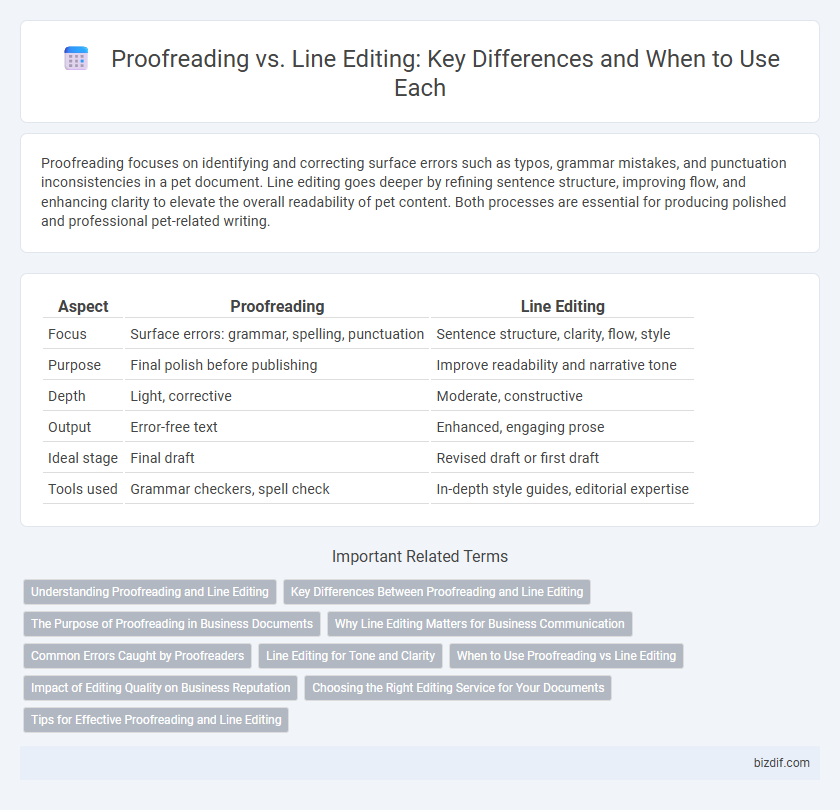Proofreading focuses on identifying and correcting surface errors such as typos, grammar mistakes, and punctuation inconsistencies in a pet document. Line editing goes deeper by refining sentence structure, improving flow, and enhancing clarity to elevate the overall readability of pet content. Both processes are essential for producing polished and professional pet-related writing.
Table of Comparison
| Aspect | Proofreading | Line Editing |
|---|---|---|
| Focus | Surface errors: grammar, spelling, punctuation | Sentence structure, clarity, flow, style |
| Purpose | Final polish before publishing | Improve readability and narrative tone |
| Depth | Light, corrective | Moderate, constructive |
| Output | Error-free text | Enhanced, engaging prose |
| Ideal stage | Final draft | Revised draft or first draft |
| Tools used | Grammar checkers, spell check | In-depth style guides, editorial expertise |
Understanding Proofreading and Line Editing
Proofreading involves meticulously checking a text for spelling, grammar, punctuation, and formatting errors to ensure accuracy and consistency. Line editing focuses on enhancing the flow, clarity, and tone of the writing by refining sentence structure, word choice, and overall readability. Understanding the distinct goals of proofreading and line editing helps writers achieve polished and engaging content.
Key Differences Between Proofreading and Line Editing
Proofreading involves checking for surface-level errors such as grammar, punctuation, spelling, and formatting inconsistencies, ensuring the text is polished and error-free. Line editing focuses on improving sentence structure, clarity, flow, and style to enhance readability and overall narrative quality. The key difference lies in proofreading addressing technical accuracy, while line editing emphasizes content refinement and tone adjustment.
The Purpose of Proofreading in Business Documents
Proofreading in business documents ensures error-free communication by meticulously checking for spelling, grammar, and punctuation mistakes. It enhances document professionalism and credibility, which is crucial for maintaining client trust and upholding company reputation. Accurate proofreading prevents costly misunderstandings and supports clear, effective business interactions.
Why Line Editing Matters for Business Communication
Line editing enhances clarity and tone by refining sentence structure and word choice, crucial for professional business communication. It ensures messages are not only error-free but also engaging and persuasive, aligning with brand voice and audience expectations. This level of editing improves reader comprehension and trust, ultimately supporting effective decision-making and relationship building in a competitive market.
Common Errors Caught by Proofreaders
Proofreaders primarily catch common errors such as spelling mistakes, punctuation issues, and formatting inconsistencies that can undermine the professionalism of a text. They identify typographical errors, incorrect capitalization, and missing or extra words to ensure clarity and accuracy. This meticulous attention to detail helps produce a polished manuscript ready for publication.
Line Editing for Tone and Clarity
Line editing enhances tone and clarity by focusing on sentence structure, word choice, and flow to ensure the narrative voice is consistent and compelling throughout the text. Unlike proofreading, which corrects grammar and spelling errors, line editing delves deeper into refining style and readability, making the writing more engaging and impactful. Editors performing line edits pay close attention to pacing, sentence rhythm, and emotional resonance to maintain the author's intended tone.
When to Use Proofreading vs Line Editing
Proofreading is ideal for the final stage of the writing process, focusing on correcting surface errors such as typos, punctuation mistakes, and formatting inconsistencies to ensure the text is polished and error-free. Line editing is best used earlier, addressing sentence structure, flow, clarity, and word choice to enhance readability and improve the overall quality of the writing. Writers should opt for line editing when revising drafts and proofreading when preparing the manuscript for publication or submission.
Impact of Editing Quality on Business Reputation
Proofreading and line editing significantly influence business reputation by ensuring content clarity and professionalism, which directly affects audience trust and brand credibility. High-quality editing eliminates errors and refines language style, making communications more persuasive and reliable. Businesses that prioritize meticulous editing cultivate stronger market presence and enhance customer loyalty through polished, error-free content.
Choosing the Right Editing Service for Your Documents
Proofreading targets surface-level errors such as typos, grammar mistakes, and punctuation inconsistencies to ensure your document is polished and error-free. Line editing involves a deeper review, enhancing language clarity, style, sentence structure, and overall flow to improve readability and engagement. Selecting the right service depends on your document's needs--choose proofreading for final touches and line editing for comprehensive improvements in tone and expression.
Tips for Effective Proofreading and Line Editing
Proofreading requires meticulous attention to grammar, punctuation, and spelling errors to ensure a polished final draft, while line editing focuses on enhancing sentence structure, clarity, and tone for better readability. To maximize effectiveness, utilize tools like Grammarly for initial error detection and read text aloud to catch awkward phrasing during line editing. Creating a checklist of common errors and taking breaks between editing sessions improves objectivity and accuracy in both proofreading and line editing processes.
Proofreading vs Line Editing Infographic

 bizdif.com
bizdif.com